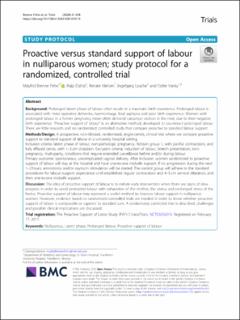| dc.contributor.author | Fehn, Møyfrid Brenne | |
| dc.contributor.author | Dahlø, Raija H. T. | |
| dc.contributor.author | Nielsen, Renate | |
| dc.contributor.author | Laache, Ingebjørg | |
| dc.contributor.author | Vanky, Eszter | |
| dc.date.accessioned | 2021-03-19T11:15:12Z | |
| dc.date.available | 2021-03-19T11:15:12Z | |
| dc.date.created | 2020-05-04T16:09:37Z | |
| dc.date.issued | 2020 | |
| dc.identifier.citation | BMC Pregnancy and Childbirth. 2020, 21, . | en_US |
| dc.identifier.issn | 1471-2393 | |
| dc.identifier.uri | https://hdl.handle.net/11250/2734439 | |
| dc.description.abstract | Background
Prolonged latent phase of labour often results in a traumatic birth experience. Prolonged labour is associated with more operative deliveries, haemorrhage, fetal asphyxia and poor birth experience. Women with prolonged labour in a former pregnancy more often demand caesarean section in the next, due to their negative birth experience. “Proactive support of labour” is an alternative method, developed to counteract prolonged labour. There are little research and no randomized controlled study that compare proactive to standard labour support.
Methods/Design
A prospective, non-blinded, randomized, single-centre, clinical trial where we compare proactive support to standard support of labour in a university hospital setting.
Inclusion criteria: latent phase of labour, non-pathologic pregnancy. Robson group 1, with painful contractions, and fully effaced cervix, with 1–3 cm dilatation. Exclusion criteria: induction of labour, breech presentation, twin pregnancy, multi-parity, conditions that require extended surveillance before and/or during labour.
Primary outcome: spontaneous, uncomplicated vaginal delivery. After inclusion, women randomized to proactive support of labour will stay at the hospital and have one-to-one midwife support. If no progression during the next 1–2 hours, amniotomy and/or oxytocin stimulation will be started. The control group will adhere to the standard procedures for labour support: expectance until established regular contractions and 4–5 cm cervical dilatation, and then one-to-one midwife support.
Discussion
The idea of proactive support of labour is to initiate early intervention when there are signs of slow progress in order to avoid protracted labour with exhaustion of the mother, the uterus and prolonged stress of the foetus. Proactive support of labour may represent a useful method to improve labour support in nulliparous women. However, evidence based on randomized controlled trials are needed in order to know whether proactive support of labour is comparable or superior to standard care. A randomized, controlled trial is described; challenges and possible clinical implications are discussed. | en_US |
| dc.language.iso | eng | en_US |
| dc.publisher | BioMed Central | en_US |
| dc.rights | Navngivelse 4.0 Internasjonal | * |
| dc.rights.uri | http://creativecommons.org/licenses/by/4.0/deed.no | * |
| dc.title | Proactive versus standard support of labour in nulliparous women; study protocol for a randomized, controlled trial | en_US |
| dc.type | Peer reviewed | en_US |
| dc.type | Journal article | en_US |
| dc.description.version | publishedVersion | en_US |
| dc.source.pagenumber | 9 | en_US |
| dc.source.volume | 21 | en_US |
| dc.source.journal | BMC Pregnancy and Childbirth | en_US |
| dc.identifier.doi | 10.1186/s13063-020-4191-9 | |
| dc.identifier.cristin | 1809279 | |
| dc.description.localcode | This article is licensed under a Creative Commons Attribution 4.0 International License, which permits use, sharing, adaptation, distribution and reproduction in any medium or format, as long as you give appropriate credit to the original author(s) and the source, provide a link to the Creative Commons licence, and indicate if changes were made. The images or other third party material in this article are included in the article's Creative Commons licence, unless indicated otherwise in a credit line to the material. If material is not included in the article's Creative Commons licence and your intended use is not permitted by statutory regulation or exceeds the permitted use, you will need to obtain permission directly from the copyright holder. To view a copy of this licence, visit http://creativecommons.org/licenses/by/4.0/. The Creative Commons Public Domain Dedication waiver (http://creativecommons.org/publicdomain/zero/1.0/) applies to the data made available in this article, unless otherwise stated in a credit line to the data. | en_US |
| dc.source.articlenumber | 358 | en_US |
| cristin.ispublished | true | |
| cristin.fulltext | original | |
| cristin.qualitycode | 1 | |

